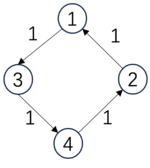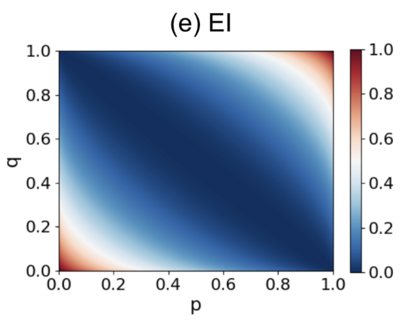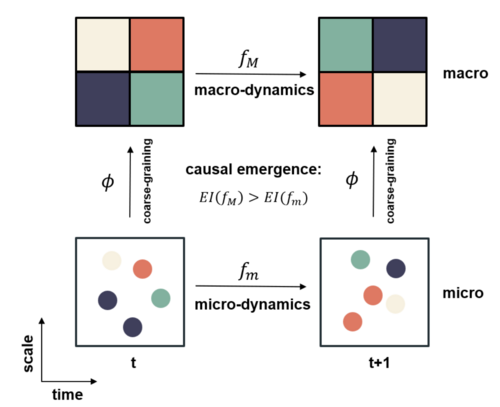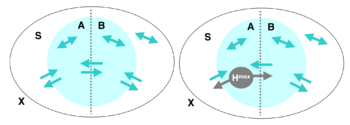Effective Information
Effective Information (EI) is a core concept in the theory of Causal Emergence, used to measure the strength of causal effects in Markov dynamics. In this context, causal effect refers to the extent to which different input distributions lead to different output distributions when viewing the dynamics as a black box. The degree of this connection is the causal effect. EI can typically be decomposed into two components: Determinism and Degeneracy. Determinism indicates how well the next state of the system can be predicted from its previous state, while Degeneracy refers to how well one can infer the previous state from the next state. A system with higher Determinism or lower Degeneracy will have higher Effective Information. In this page, all [math]log[/math] represent logarithmic operations with a base of 2.
Historical Background
The concept of Effective Information (EI) was first introduced by Giulio Tononi in 2003 as a key measure in Integrated Information Theory[1]. A system is said to have a high degree of integration when there is a strong causal connection among its components, and EI is the metric used to quantify this degree of causal connection.
In 2013, Giulio Tononi's student, Erik Hoel, further refined the concept of EI to quantitatively characterize emergence, leading to the development of the theory of Causal Emergence[2]. In this theory, Hoel used Judea Pearl’s "do" operator to modify the general mutual information metric, which made EI fundamentally different from mutual information. While mutual information measures correlation, EI—due to the use of the "do" operator—measures causality. The article also introduced a normalized version of EI, referred to as Eff.
Traditionally, EI was primarily applied to discrete-state Markov chains. To extend this to continuous domains, P. Chvykov and E. Hoel collaborated in 2020 to propose the theory of Causal Geometry, expanding EI's definition to function mappings with continuous state variables. By incorporating Information Geometry, they explored a perturbative form of EI and compared it with Fisher Information, proposing the concept of Causal Geometry. However, this method of calculating EI for continuous variables required the assumption of infinitesimal variance for normal distribution variables, which was an overly stringent condition.
In 2022, to address the calculation of EI in general feedforward neural networks, Zhang Jiang and Liu Kaiwei removed the variance constraint from the Causal Geometry approach and explored a more general form of EI. Nonetheless, a limitation remained: because the uniform distribution of variables in the real-number domain is strictly defined over an infinite space, the calculation of EI involved a parameter [math]L[/math], representing the range of the uniform distribution. To avoid this issue and enable comparisons of EI at different levels of granularity, the authors proposed the concept of dimension-averaged EI. They found that the measure of causal emergence defined by dimension-averaged EI was solely dependent on the determinant of the neural network's Jacobian matrix and the variance of the random variables in the two compared dimensions, independent of other parameters such as [math]L[/math]. Additionally, dimension-averaged EI could be viewed as a normalized EI, or Eff.
Essentially, EI is a quantity that depends only on the dynamics of a Markov system—specifically on the Markov state transition matrix—and is independent of the distribution of state variables. However, this point was not previously highlighted. In a 2024 review by Yuan Bing and others, the authors emphasized this fact and provided an explicit form of EI that depends only on the Markov state transition matrix. In their latest work on dynamical reversibility and causal emergence, Zhang Jiang and colleagues pointed out that EI is actually a characterization of the reversibility of the underlying Markov transition matrix, and they attempted to directly characterize the reversibility of Markov chain dynamics as a replacement for EI.
Overview
The EI metric is primarily used to measure the strength of causal effects in Markov dynamics. Unlike general causal inference theories, EI is used in cases where the dynamics (the Markov transition probability matrix) are known and no unknown variables (i.e., confounders) are present. Its core objective is to measure the strength of causal connections, rather than the existence of causal effects. This means EI is more suitable for scenarios where a causal relationship between variables X and Y is already established.
Formally, EI is a function of the causal mechanism (in a discrete-state Markov chain, this is the probability transition matrix of the Markov chain) and is independent of other factors. The formal definition of EI is:
EI(P)≡I(Y;X∣do(X∼U))
where P represents the causal mechanism from X to Y, which is a probability transition matrix, [math]p_{ij} \equiv Pr(Y=j|X=i)[/math]; X is the cause variable, Y is the effect variable, and [math]do(X \sim U)[/math] denotes the intervention on X, changing its distribution to a uniform one. Under this intervention, and assuming the causal mechanism P remains unchanged, Y will be indirectly affected by the intervention on X. EI measures the mutual information between X and Y after this intervention.
The introduction of the "do" operator aims to eliminate the influence of X's distribution on EI, ensuring that the final EI metric is only a function of the causal mechanism f and is independent of X's distribution.
Below are three examples of Markov chains, with their respective EI values included:
| [math]\displaystyle{ P_1=\begin{pmatrix} &0 &0 &1 &0& \\ &1 &0 &0 &0& \\ &0 &0 &0 &1& \\ &0 &1 &0 &0& \\ \end{pmatrix} }[/math], | [math]\displaystyle{ P_2=\begin{pmatrix} &1/3 &1/3 &1/3 &0& \\ &1/3 &1/3 &1/3 &0& \\ &1/3 &1/3 &1/3 &0& \\ &0 &0 &0 &1& \\ \end{pmatrix} }[/math], | [math]\displaystyle{ P_3=\begin{pmatrix} &0 &0 &1 &0& \\ &1 &0 &0 &0& \\ &1 &0 &0 &0& \\ &1 &0 &0 &0& \\ \end{pmatrix} }[/math]. |
| [math]\begin{aligned}&EI(P_1)=2\ bits,\\&Det(P_1)=2\ bits,\\&Deg(P_1)=0\ bits\end{aligned}[/math] | [math]\begin{aligned}&EI(P_2)=0.81\ bits,\\&Det(P_2)=0.81\ bits,\\&Deg(P_2)=0\ bits\end{aligned}[/math] | [math]\begin{aligned}&EI(P_3)=0.81\ bits\\&Det(P_3)=2\ bits,\\&Deg(P_3)=1.19\ bits.\end{aligned}[/math] |
-
(example)
As we can see, the EI of the first matrix [math]P_1[/math] is higher than that of the second [math]P_2[/math] because this probability transition is fully deterministic: starting from a particular state, it transitions to another state with 100% probability. However, not all deterministic matrices correspond to high EI, such as matrix [math]P_3[/math]. Although its transition probabilities are also either 100% or 0, because all of the last three states transition to the first state, we cannot distinguish which state it was in the previous moment. Therefore, its EI is low, which we call degeneracy. Hence, if a transition matrix has high determinism and low degeneracy, its EI will be high. Additionally, EI can be decomposed as follows:
EI=Det−Deg
where Det stands for Determinism, and Deg stands for Degeneracy. EI is the difference between the two. In the table, we also list the values of Det and Deg corresponding to the matrices.
The first transition probability matrix is a permutation matrix and is reversible; thus, it has the highest determinism, no degeneracy, and therefore the highest EI. The second matrix's first three states transition to each other with a 1/3 probability, resulting in the lowest determinism but also low degeneracy, yielding an EI of 0.81. The third matrix, despite having binary transitions, has high degeneracy because all three states transition to state 1, meaning we cannot infer their previous state. Thus, its EI equals that of the second matrix at 0.81.
Although EI was originally applied to discrete-state Markov chains, Zhang Jiang, Liu Kaiwei, and Yang Mingzhe extended the definition to more general continuous-variable cases. This extension builds on EI's original definition by intervening on the cause variable X as a uniform distribution over a sufficiently large bounded interval, [math][-\frac{L}{2}, \frac{L}{2}]^n[/math]. The causal mechanism is assumed to be a conditional probability that follows a Gaussian distribution with a mean function [math]f(x)[/math] and covariance matrix [math]\Sigma[/math]. Based on this, the EI between the causal variables is then measured. The causal mechanism here is determined by the mapping [math]f(x)[/math] and the covariance matrix, which together define the conditional probability [math]Pr(y|x)[/math].
More detailed explanations follow.
The Do-Operator and Its Explanation
The original definition of effective information (EI) was based on discrete Markov chains. However, to expand its applicability, we explore a more general form of EI here.
Formal Definition
Consider two random variables, X and Y, representing the cause variable and the effect variable, respectively. Let their value ranges be X and Y. The effective information (EI) from X to Y is defined as:
EI≡I(X:Y∣do(X∼U(X)))≡I(X~:Y~)
Here, do(X∼U(X)) represents applying a do-intervention (or do-operator) on X, making it follow a uniform distribution U(X) over X, which corresponds to a maximum entropy distribution. X~ and Y~ represent the variables after the do-intervention on X and Y, respectively, where:
Pr(X~=x)=#(X)1
This means that the main difference between X~ after the intervention and X before the intervention is their distributions: X~ follows a uniform distribution over X, while X may follow any arbitrary distribution. #(X) represents the cardinality of the set X, or the number of elements in the set if it is finite.
According to Judea Pearl’s theory, the do-operator cuts off all causal arrows pointing to variable X, while keeping other factors unchanged, particularly the causal mechanism from X to Y. The causal mechanism is defined as the conditional probability of Y taking any value y∈Y given X takes a value x∈X:
f≡Pr(Y=y∣X=x)
In the intervention, this causal mechanism f remains constant. When no other variables are influencing the system, this leads to a change in the distribution of Y, which is indirectly intervened upon and becomes:
Pr(Y~=y)=x∈X∑Pr(X=x)Pr(Y=y∣X=x)=x∈X∑#(X)Pr(Y=y∣X=x)
Here, Y~ represents the modified distribution of Y after the do-intervention on X, reflecting how the distribution of Y changes indirectly due to the intervention on X.
Therefore, the effective information (EI) of a causal mechanism f is the mutual information between the intervened cause variable X~ and the intervened effect variable Y~.
Why Use the Do-Operator?
While EI is essentially a measure of mutual information, it differs from traditional mutual information by including the do-operator, which applies an intervention to the input variable. Why is this intervention necessary?
According to Judea Pearl’s ladder of causality, causal inference can be divided into three levels: association, intervention, and counterfactuals. The higher the level, the stronger the causal features. Directly estimating mutual information from observational data measures the level of association. If we can intervene in the variables, i.e., set a variable to a specific value or make it follow a particular distribution, we move up to the intervention level. By introducing the do-operator in the definition of EI, we allow EI to capture causal features more effectively than mutual information alone.
From a practical perspective, incorporating the do-operator in EI’s calculation separates the data from the dynamics, eliminating the effect of the data distribution (i.e., the distribution of X) on the EI measurement. In causal graphs, the do-operator cuts off all causal arrows pointing to the intervened variable, preventing confounding factors from creating spurious associations. Similarly, in EI’s definition, the do-operator removes all causal arrows pointing to the cause variable X, including influences from other variables (both observable and unobservable). This ensures that EI captures the intrinsic characteristics of the dynamics itself.
The introduction of the do-operator makes EI distinct from other information metrics. The key difference is that EI is solely a function of the causal mechanism, which allows it to more precisely capture the essence of causality compared to other metrics like transfer entropy. However, this also means that EI requires knowledge of or access to the causal mechanism, which may be challenging if only observational data is available.
Why Intervene to Achieve a Uniform Distribution?
In Erik Hoel's original definition, the do operation intervenes on the dependent variable X, transforming it into a uniform distribution over its domain X (which is also the maximum entropy distribution). So, why should we intervene to achieve a uniform distribution? Can other distributions be used?
Firstly, according to the previous section, the essence of the do operation is to allow the Effective Information (EI) to better describe the nature of the causal mechanism f. Therefore, it is necessary to sever the connection between the dependent variable X and other variables and change its distribution so that the EI metric becomes independent of the distribution of X.
The reason for intervening to achieve a uniform distribution for the input variable is to more accurately characterize the properties of the causal mechanism.
This is because, when both X and Y are finite, countable sets, the causal mechanism f≡Pr(Y=y∣X=x) becomes a matrix with #(X) rows and #(Y) columns. We can expand the definition of EI:
-
[math]\displaystyle{ \begin{aligned} EI &= I(X,Y|do(X)\sim U)= \sum_{x\in\mathcal{X}}\sum_{y\in\mathcal{Y}}Pr(X=x,Y=y)\log \frac{Pr(X=x,Y=y)}{Pr(X=x)Pr(Y=y)}\\ &= \sum_{x\in\mathcal{X}}\sum_{y\in\mathcal{Y}}Pr(X=x)Pr(Y=y|X=x)\log \frac{Pr(Y=y|X=x)}{Pr(Y=y)}\\ &= \sum_{x\in\mathcal{X}}\sum_{y\in\mathcal{Y}}Pr(X=x)Pr(Y=y|X=x)\log Pr(Y=y|X=x)- \sum_{x\in\mathcal{X}}\sum_{y\in\mathcal{Y}}Pr(X=x)Pr(Y=y|X=x)\log Pr(Y=y) \\ &=\frac{1}{\#(\mathcal{X})}\left(-\sum_{x\in\mathcal{X}}H(Pr(Y|X))\right) + H(Pr(Y)) \end{aligned} }[/math]
(1)
It is easy to see that the final equation tells us that EI is actually composed of two terms: the first term is the average of the negative entropy of each row of the causal mechanism matrix, and the second term is the entropy of the variable Y. In the first term, the probability distribution Pr(X=x) of X acts as the weight when averaging the entropy of each row. Only when we set this weight to be the same value (i.e., intervene to make X uniformly distributed) can we treat each row of the causal mechanism matrix equally.
If the distribution is not uniform, some rows will be assigned a larger weight, while others will be given a smaller weight. This weight represents a certain "bias," which prevents the EI from reflecting the natural properties of the causal mechanism.
Effective Information of Markov Chains
Introduction to Markov Chains
In this section, all Markov transition probability matrices are denoted as P. N is the total number of states.
Erik Hoel and colleagues first proposed the measure of causality, Effective Information (EI), on the Markov dynamics with discrete states, also known as Markov chains. Therefore, this section introduces the specific form of EI on Markov chains.
A Markov chain refers to a type of stationary stochastic process with discrete states and discrete time. Its dynamics can generally be represented by a Transitional Probability Matrix (TPM), also known as a probability transition matrix or state transition matrix.
Specifically, a Markov chain consists of a set of random variables Xt, which take values in the state space X={1,2,⋯,N}, where t typically represents time. A transition probability matrix is a probability matrix, where the element in the i-th row and j-th column, pij, represents the probability of the system transitioning from state i at any time t to state j at time t+1. Each row satisfies the normalization condition: ∑j=1Npij=1.
[math]\displaystyle{ \sum_{j=1}^Np_{ij}=1, }[/math]
The state transition matrix can be viewed as the dynamics of the Markov chain because the probability distribution of the state at any time t+1, Pr(Xt), can be uniquely determined by the probability distribution of the state at the previous time t and the state transition matrix, satisfying the relationship: Pr(Xt+1=j)=∑i=1Npij⋅Pr(Xt=i), where i,j∈X are arbitrary states in X, and N=#(X), the total number of states in X.
[math]\displaystyle{ Pr(X_{t+1}=j)=\sum_{i=1}^N p_{ij}\cdot Pr(X_t=i), }[/math]
The following table presents three different transition probability matrices and their EI values:
| [math]\displaystyle{ P_1=\begin{pmatrix} &0 &0 &1 &0& \\ &1 &0 &0 &0& \\ &0 &0 &0 &1& \\ &0 &1 &0 &0& \\ \end{pmatrix} }[/math], | [math]\displaystyle{ P_2=\begin{pmatrix} &1/3 &1/3 &1/3 &0& \\ &1/3 &1/3 &1/3 &0& \\ &0 &0 &0 &1& \\ &0 &0 &0 &1& \\ \end{pmatrix} }[/math], | [math]\displaystyle{ P_3=\begin{pmatrix} &1/4 &1/4 &1/4 &1/4& \\ &1/4 &1/4 &1/4 &1/4& \\ &1/4 &1/4 &1/4 &1/4& \\ &1/4 &1/4 &1/4 &1/4& \\ \end{pmatrix} }[/math]. |
| [math]EI(P_1)=2[/math] bits | [math]EI(P_2)=1[/math] bits | [math]EI(P_3)=0[/math] bits |
For these three Markov chains, the state space is X={1,2,3,4}, so the size of their TPM is 4×4.
EI of Markov Chains
In a Markov chain, the state variable at any time Xt can be considered as the cause, and the state variable at the next time Xt+1 can be considered as the effect. Thus, the state transition matrix of a Markov chain is its causal mechanism. Therefore, we can apply the definition of Effective Information to Markov chains. [math]\displaystyle{ \begin{aligned} EI &= I(X_t,X_{t+1}|do(X_t)\sim U(\mathcal{X}))=I(\tilde{X}_t,\tilde{X}_{t+1}) \\ &= \sum^N_{i=1}\sum^N_{j=1}Pr(\tilde{X}_t=i,\tilde{X}_{t+1}=j)\log \frac{Pr(\tilde{X}_t=i,\tilde{X}_{t+1}=j)}{Pr(\tilde{X}_t=i)Pr(\tilde{X}_{t+1}=j)}\\ &= \sum^N_{i=1}Pr(\tilde{X}_t=i)\sum^N_{j=1}Pr(\tilde{X}_{t+1}=j|\tilde{X}_t=i)\log \frac{Pr(\tilde{X}_{t+1}=j|\tilde{X}_t=i)}{Pr(\tilde{X}_{t+1}=j)}\\ &= \frac{1}{N}\sum^N_{i=1}\sum^N_{j=1}p_{ij}\log\frac{N\cdot p_{ij}}{\sum_{k=1}^N p_{kj}} \end{aligned} }[/math]
Here, X~t,X~t+1 are the states at times t and t+1 after intervening to make Xt uniformly distributed, and pij is the probability of transitioning from state i to state j. From this equation, it is clear that EI is merely a function of the probability transition matrix P.
Vector Form of EI in Markov Chains
We can also represent the transition probability matrix P as a concatenation of N row vectors, i.e.:
[math]\displaystyle{ P=(P_1,P_2,\cdots,P_N)^T }[/math]
Where Pi is the i-th row vector of matrix P, and it satisfies the normalization condition for conditional probabilities: ∣∣Pi∣∣1=1, where ∣∣⋅∣∣1 denotes the L1-norm of a vector. Then, EI can be written as follows:
-
[math]\displaystyle{ \begin{aligned} EI &= \frac{1}{N}\sum^N_{i=1}\sum^N_{j=1}p_{ij}\log\frac{N\cdot p_{ij}}{\sum_{k=1}^N p_{kj}}\\ &=\frac{1}{N}\cdot \sum_{i=1}^N\left(P_i\cdot \log P_i - P_i\cdot\log \bar{P}\right)\\ &=\frac{1}{N}\sum_{i=1}^N D_{KL}(P_i||\bar{P}) \end{aligned} }[/math]
(2)
By averaging the columns of the matrix, we obtain the average transition vector P=∑k=1NPk/N. DKL is the KL divergence between two distributions. Therefore, EI is the average KL divergence between each row transition vector Pi and the average transition vector P.
For the three state transition matrices listed above, their respective EI values are: 2 bits, 1 bit, and 0 bits. This shows that if more 0s or 1s appear in the transition probability matrix (i.e., if more of the row vectors are one-hot vectors, where one position is 1 and the others are 0), the EI value will be higher. In other words, the more deterministic the jump from one time to the next, the higher the EI value tends to be. However, this observation is not entirely precise, and more exact conclusions are provided in the following sections.
Normalization
Clearly, the magnitude of EI (Effective Information) is related to the size of the state space, which poses challenges when comparing Markov chains of different scales. To address this issue, we need a causal measure that is as independent of scale effects as possible. Therefore, we normalize EI to derive a metric that is independent of the system size.
According to the work of Erik Hoel and Tononi, the normalization process involves using the entropy under a uniform (i.e., maximum entropy) distribution as the denominator, which is [math]\log N[/math], where [math]N[/math] is the number of states in the state space [math]\mathcal{X}[/math][1]. Thus, the normalized EI becomes: Normalized EI=logNEI
[math]\displaystyle{ Eff=\frac{EI}{\log N} }[/math]
This normalized metric is also referred to as effectiveness.
However, when dealing with continuous state variables, normalizing EI by using the logarithm of the number of states in the state space may not be suitable, as the state number often depends on the dimensionality and the resolution of real numbers.
Determinism and Degeneracy
Decomposition of EI
根据公式1,我们发现,EI实际上可以被分解为两项,即:
[math]\displaystyle{ \begin{aligned} EI&=\frac{1}{\#(\mathcal{X})} \left(-\sum_{x\in\mathcal{X}}H(Pr(Y|X))\right) + H\left(Pr(Y)\right)\\ \end{aligned} }[/math]
同样,在马尔科夫链的情景下,EI也可以做这样的分解:
-
[math]\displaystyle{ \begin{aligned} EI &= \frac{1}{N}\cdot \sum_{i=1}^N\left(P_i\cdot \log P_i - P_i\cdot\log \bar{P}\right)\\ &=\underbrace{-\langle H(P_i)\rangle}_{确定性项}+\underbrace{H(\bar{P})}_{非简并性项} \end{aligned} }[/math]
(tow_terms)
其中,第一项:[math]-\langle H(P_i)\rangle\equiv \frac{1}{N}\sum_{i=1}^N H(P_i)[/math]为每个行向量[math]P_i[/math]的负熵的平均值,它刻画了整个马尔科夫转移矩阵的确定性(determinism);
第二项:[math]H(\bar{P})[/math]为平均行向量的熵,其中[math]\bar{P}\equiv \frac{1}{N}\sum_{i=1}^N P_i [/math]为所有N个行向量的平均行向量,它刻画了整个马尔科夫转移矩阵的非简并性或非退化性(non-degeneracy)。
确定性与简并性
然而上述定义中的确定性项和非简并性都是负数,为此,我们重新定义一个马尔科夫链转移矩阵P的确定性为:
[math]\displaystyle{ Determinism \equiv \log N - \langle H(P_i)\rangle = \frac{1}{N}\sum_{i=1}^N \sum_{j=1}^N p_{ij}\log \left(N\cdot p_{ij}\right) }[/math]
这一项是一个平均的负熵,为了防止其为负数,所以加上了[math]\log N[/math][1]。Determinism能刻画整个转移矩阵的确定性:也就是说如果我们知道了系统当前时刻所处的状态,则我们能够推断出系统在下一时刻所处的状态的程度。为什么这么说呢?这是因为确定性这一项是所有行向量熵的平均值,再取一个负号。我们知道,当一个向量更靠近均匀分布的时候,它的熵就越大,相反,如果一个向量越靠近一个“独热”(one-hot)的向量,也就是这个向量中只有一个1,其它元素都是0,那么它的熵就越小。我们知道,马尔科夫概率转移矩阵的一个行向量的含义就代表系统从当前状态转移到各个不同状态的概率大小。那么,当平均的行向量负熵大的时候,也就是这个行向量的某一个单元概率为1,其它为0,这就意味着系统能够确定地转移到1对应的状态。
我们定义一个马尔科夫链转移矩阵P的简并性为:
[math]\displaystyle{ Degeneracy \equiv \log N - H(\bar{P})=\log N + \sum_{j=1}^N \bar{P}_{\cdot j}\log \bar{P}_{\cdot j}=\sum_{j=1}^N \frac{\sum_{i=1}^Np_{ij}}{N}\log \left(\sum_{i=1}^Np_{ij}\right) }[/math]
这一项为简并性或叫退化性,为了防止其为负数,所以加上了[math]\log N[/math][1]。这里的“简并性”的含义是:如果知道了系统的当前状态,能不能反推系统在上一时刻的状态的能力,如果可以推断,则这个马尔科夫矩阵的简并性就会比较低,也就是非简并的;而如果很难推断,则马尔科夫矩阵就是简并的,也即退化的。为什么“简并性”可以用平均行向量分布的负熵来刻画呢?这是因为,首先,当所有的P中的行向量都是彼此独立的独热向量,那么它们的平均分布就会非常接近于一个均匀分布,即[math]\bar{P}\approx (\frac{1}{N},\frac{1}{N},\cdots,\frac{1}{N})[/math],这个时候,它的Shannon熵最大,即[math]\log N[/math]。而在此时,这个马尔科夫转移矩阵是一个可逆矩阵(由彼此独立的“独热”向量形成的全体彼此线性无关,因此矩阵满秩,因此是可逆的)。这也就意味着,我们从系统当前的状态,是可以推断出系统的上一时刻的状态的,所以这个马尔科夫转移矩阵是非简并的,计算出的简并度恰恰也为0;
其次,当P中的行向量都是相同的独热向量的时候,则平均向量也是一个独热的向量,而这种向量的熵是最小的。在此时,由于所有的上一时刻状态都会转移到行向量中1对应的状态,因此我们也就很难推断出当前这个状态是由哪一个上一步的状态转移过来的。因此,这种情形下的马尔科夫矩阵是简并的(或退化的),计算出来的简并度则恰恰是[math]\log N[/math]。
对于更一般的情况,如果P中的行向量靠近一个彼此独立的独热行向量构成的矩阵,则P就越非简并,相反,如果行向量彼此相同且靠近同一个独热向量,则P就越简并。
举例
下面,我们以三个马尔科夫链为例,来考察它们的确定性和简并性
| [math]\displaystyle{ P_1=\begin{pmatrix} &0 &0 &1 &0& \\ &1 &0 &0 &0& \\ &0 &0 &0 &1& \\ &0 &1 &0 &0& \\ \end{pmatrix} }[/math], | [math]\displaystyle{ P_2=\begin{pmatrix} &1/3 &1/3 &1/3 &0& \\ &1/3 &1/3 &1/3 &0& \\ &1/3 &1/3 &1/3 &0& \\ &0 &0 &0 &1& \\ \end{pmatrix} }[/math], | [math]\displaystyle{ P_3=\begin{pmatrix} &0 &0 &1 &0& \\ &1 &0 &0 &0& \\ &1 &0 &0 &0& \\ &1 &0 &0 &0& \\ \end{pmatrix} }[/math]. |
| [math]\begin{aligned}&Det(P_1)=2\ bits,\\&Deg(P_1)=0\ bits,\\&EI(P_1)=2\ bits\end{aligned}[/math] | [math]\begin{aligned}&Det(P_2)=0.81\ bits,\\&Deg(P_2)=0\ bits,\\&EI(P_2)=0.81\ bits\end{aligned}[/math] | [math]\begin{aligned}&Det(P_3)=2\ bits,\\&Deg(P_3)=1.19\ bits,\\&EI(P_3)=0.81\ bits\end{aligned}[/math] |
第一个转移概率矩阵是一个置换排列矩阵(Permutation),它是可逆的,因此确定性最高,没有简并性,因而EI最大;第二个矩阵的前三个状态都会以1/3的概率跳转到彼此,因此确定性程度最低,而非简并,EI是0.81;第三个矩阵虽然也是确定性的矩阵,因而确定性最高,但是由于后三个状态都跳转到1,因此,从1状态不能推知它来自于哪个状态,因此简并性最高,最终的EI与第二个相同,仍然是0.81。
归一化的确定性与简并性
在Erik Hoel等人的原始论文中[1],作者们定义的确定性和简并性是以归一化的形式呈现的,也就是将确定性和简并性除以了一个与系统尺度有关的量。为了区分,我们将归一化的对应量称为确定性系数和简并性系数。
具体地,Erik Hoel等人将归一化后的有效信息,即Eff进行分解,分别对应确定性系数(determinism coefficient)和简并性系数(degeneracy coefficient)。
[math]\displaystyle{ Eff = Determinism\ Coefficient - Degeneracy\ Coefficient }[/math]
这两项的定义分别是:
[math]\displaystyle{ \begin{aligned} &Determinism\ Coefficient = \frac{1}{N\log N}\sum_{i,j}p_{ij}\log\left(N\cdot {p_{ij}}\right) \\ &Degeneracy\ Coefficient = \frac{1}{N\log N}\sum_{ij}p_{ij}\log{\left(\sum_k p_{k,j}\right)} \end{aligned} }[/math]
总之,确定性指的是,已知当前时刻状态概率分布,对未来可能状态的判断有多大的把握;而简并性指的是,已知当前的状态,追溯历史,我们能有多大确定性做出判断。如果有状态在动力学过程中发生简并,我们回溯历史时能运用的信息就会变少。当一个系统背后的动力学确定性高,同时简并性低时,说明这是一个具有明显因果效应的动力学。
EI的函数性质
由公式2可以看出,在概率转移矩阵P上,EI是关于矩阵中每一个元素(从某一状态到另一状态的条件概率)的函数,于是我们自然会问:这样一个函数具有哪些数学性质?如它有没有极值点?极值点在哪里?凸性如何?最大值和最小值又是多少?
定义域
在离散状态和离散时间的马尔科夫链上,EI的定义域显然是概率转移矩阵P。P是一个由[math]N\times N[/math]个元素构成的矩阵,其中每一个元素[math]p_{ij}\in[0,1][/math]代表一个概率值,同时对于任意的行,这组概率值需要满足归一化条件,也就是对于任意的[math]\forall i\in[1,N][/math]:
-
[math]\displaystyle{ ||P_i||_1=\sum_{j=1}^N p_{ij}=1 }[/math]
(3)
因此EI的定义域,也就是P的可能空间并不是全部[math]N\times N[/math]维的实数空间[math]\mathcal{R}^{N^2}[/math],由于归一化条件3的存在,使得该定义域成为一个[math]N\times N[/math]维实数空间中的一个子空间。如何表达这个子空间呢?
首先,对于任意一个行向量[math]P_i[/math]来说,它的取值范围空间为N维实数空间中的一个超正多面体。例如,当[math]N=2[/math]的时候,该空间为一条直线:[math]p_{i,1}+p_{i,2}=1, \forall i\in\{1,2\}[/math]。当[math]N=3[/math]的时候,该空间为一张三维空间中的平面:[math]p_{i,1}+p_{i,2}+p_{i,3}=1, \forall i\in\{1,2,3\}[/math]。这两个空间如下图所示:
在一般情况,我们将N维空间下的行向量[math]P_i[/math]的取值范围空间定义为[math]\Delta=\{p_{j}|\sum_{j=1}^Np_{j}=1,p_{j}\in[0,1]\}[/math],则N个这样的空间的笛卡尔积即为EI的定义域:
[math]\displaystyle{ Dom(EI)=\Delta\times \Delta\cdots\times\Delta=\Delta^N }[/math]
一阶导数及极值点
对公式2求[math]p_{ij}[/math]的一阶导数,并注意到归一化条件[math]\sum_{j=1}^Np_{ij}=1[/math],则就可以得到:
-
[math]\displaystyle{ \frac{\partial EI}{\partial p_{ij}}=\log\left(\frac{p_{ij}}{p_{iN}}\right)-\log\left(\frac{\bar{p}_{\cdot j}}{\bar{p}_{\cdot N}}\right), }[/math]
(3)
其中,[math]\displaystyle{ p_{ij} }[/math]表示P中第i行第j列的条件概率,因为P每一行有归一化约束条件2,所以EI函数本身有[math]\displaystyle{ N(N-1) }[/math]个自由变元,我们可以取[math]\displaystyle{ 1\leq i\leq N, 1\leq j\leq N-1 }[/math]。[math]\displaystyle{ p_{iN} }[/math]表示第i行第N列的条件概率,[math]\displaystyle{ \bar{p}_{\cdot j}, \bar{p}_{\cdot N} }[/math]则分别表示第j列和第N列条件概率的均值。不难看出,该导数有定义的前提是对于选定的[math]i,j\in[1,N][/math],[math]p_{ij},p_{iN},\bar{p}_{\cdot j}\equiv \frac{\sum_{k=1}^Np_{kj}}{N},\bar{p}_{\cdot N}\equiv \frac{\sum_{k=1}^Np_{kN}}{N}[/math]都大于0,只有满足这个条件,则EI在[math]p_{ij}[/math]附近是可导的。否则,如果有一项为0,则导数不存在。
令式3等于0,可以求得极值点:即对于任意的[math]\displaystyle{ 1\leq i\leq N, 1\leq j\leq N-1 }[/math],都有下式的成立,
[math]\displaystyle{ p_{ij}=\bar{p}_{\cdot j}=\frac{1}{N}\sum_{k=1}^Np_{kj} }[/math]
不难计算出,此时[math]\displaystyle{ EI=0 }[/math],即EI达到了极值点。根据EI的二阶导数不难判断出,这是极小值点。换个角度来看这个公式,这意味着EI的极小值点有很多个,只要转移概率矩阵所有行向量完全一致,无论该行向量本身是怎样的分布,EI都会等于0。
二阶导数与凸性
进一步地,为了求得EI函数的凸性,我们可以求出EI这个函数的二阶导数[math]\displaystyle{ \frac{\partial^2 EI}{\partial p_{ij}\partial p_{st}} }[/math],其中[math]\displaystyle{ 1\leq s \leq N, 1\leq t \leq N-1 }[/math]。首先我们需要引入一个函数符号[math]\displaystyle{ \delta_{i,j} }[/math],
[math]\displaystyle{ \delta_{i,j} = \begin{cases} 0 & \text{if } i\ne j,\\ 1 & \text{if } i = j. \end{cases} }[/math]
于是我们可以来推导EI的二阶导数,当[math]\displaystyle{ i=s }[/math]时,
[math]\displaystyle{ \begin{equation} \begin{aligned} \frac{\partial^2 EI}{\partial p_{ij}\partial p_{it}}&=\frac{\delta_{j,t}}{N}\left(\frac{1}{p_{ij}}-\frac{1}{N\cdot \bar{p}_{\cdot j}}\right)+\frac{1}{N\cdot p_{iN}}-\frac{1}{N^2\cdot \bar{p}_{\cdot N}}\\ &=\delta_{j,t}\frac{\sum_{k=1}^{N-1}p_{k j}-p_{ij}}{N^2\cdot p_{ij}\cdot \bar{p}_{\cdot j}}+\frac{\sum_{k=1}^{N-1}p_{k N}-p_{iN}}{N^2\cdot p_{iN}\cdot \bar{p}_{\cdot N}}\\ &=\delta_{j,t}\frac{\sum_{k\neq i}p_{kj}}{N^2\cdot p_{ij}\cdot \bar{p}_{\cdot j}}+\frac{\sum_{k\neq i}p_{k N}}{N^2\cdot p_{iN}\cdot \bar{p}_{\cdot N}}\gt 0, \end{aligned} \end{equation} }[/math]
当[math]\displaystyle{ i\ne s }[/math]时,
[math]\displaystyle{ \begin{equation} \frac{\partial^2 EI}{\partial p_{ij}\partial p_{st}}=-\frac{\delta_{j,t}}{N^2\cdot \bar{p}_{\cdot j}}-\frac{1}{N^2\cdot \bar{p}_{\cdot N}}\lt 0. \end{equation} }[/math]
综上,EI的二阶导数为,
[math]\displaystyle{ \begin{equation} \frac{\partial^2 EI}{\partial p_{ij}\partial p_{st}}=\frac{1}{N}\cdot\left(\frac{\delta_{i,s}\delta_{j,t}}{p_{ij}}+\frac{\delta_{i,s}}{p_{iN}}-\frac{\delta_{j,t}}{N\cdot\bar{p}_{\cdot j}}-\frac{1}{N\cdot \bar{p}_{\cdot N}}\right). \end{equation} }[/math]
并且,二阶导数在[math]\displaystyle{ i=s }[/math]的时候为正,在[math]\displaystyle{ i\ne s }[/math]时为负。因此EI既不是凸的也不是凹的。
最小值
前面已经根据EI的一阶导数讨论了它的极值问题。即EI会在所有行向量都是同一个向量的时候达到极小值0。那么,这个极小值是不是最小的呢?
我们知道,根据公式2,EI本质上是一种KL散度,而KL散度都是非负的,也就是说:
[math]\displaystyle{ EI\geq 0 }[/math]
这个不等式的等号在[math]p_{ij}=\bar{p}_{\cdot j}[/math]对所有的[math]i,j[/math]都成立的时候能够取到。因此,0是EI的最小值,且[math]p_{ij}=\bar{p}_{\cdot j}=\frac{1}{N}\sum_{k=1}^Np_{kj}[/math]是它的最小值点,即:
[math]\displaystyle{ EI_{min}=0. }[/math]
最大值
通过前面确定性和简并性章节的讨论,我们知道EI可以拆成两部分,
[math]\displaystyle{ EI = -\langle H(P_i)\rangle + H(\bar{P}), }[/math]
其中熵的定义是[math]\displaystyle{ H(P_i)=-\sum_{j=1}^Np_{ij}\log p_{ij} }[/math]。分开来看,前一项式子最大值为0,即:
[math]\displaystyle{ - H(P_i)\leq 0, }[/math]
当[math]\displaystyle{ P_i }[/math]为没有不确定性的独热向量时,该式子的等号成立。所以,当对所有的i都有[math]\displaystyle{ P_i }[/math]为独热变量时,有
[math]\displaystyle{ -\langle H(P_i)\rangle=0 }[/math]
成立。另一边,P中所有行向量的平均向量的熵也有一个不等式成立,
[math]\displaystyle{ H(\bar{P})\leq \log N, }[/math]
其中等于号在满足[math]\displaystyle{ \bar{P}=\frac{1}{N}\cdot \mathbb{1} }[/math]条件时成立。
[math]\displaystyle{ EI\leq 0+\log N=\log N }[/math]
当这两个式子的等号同时成立时,即[math]\displaystyle{ P_i }[/math]为独热向量,同时[math]\displaystyle{ \bar{P} }[/math]为均匀分布时(此时必然要求[math]P_i[/math]彼此垂直,也就是P是一个排列置换矩阵),EI会达到最大值:
[math]\displaystyle{ EI_{max}=\log N }[/math]
最简马尔科夫链下的解析解
我们考虑一个最简单的2*2马尔科夫链矩阵:
[math]\displaystyle{ P=\begin{pmatrix}p & 1-p \\1-q & q\end{pmatrix}, }[/math]
其中 [math]p[/math] 和 [math]q[/math] 为取值 [math][0,1][/math] 的参数。
这个参数为[math]p[/math]和[math]q[/math]的转移概率矩阵的EI可以通过以下解析解计算:
[math]\displaystyle{ EI=\frac{1}{2}\left[p\log_2\frac{2p}{1+p-q}+(1-p)\log_2\frac{2(1-p)}{1-p+q}\right. + \left.(1-q)\log_2\frac{2(1-q)}{1+p-q}+q\log_2\frac{2q}{1-p+q}\right] }[/math]
下图展示了不同[math]p[/math] 和 [math]q[/math]取值的 EI 的变化。
由这张图不难看出,当p+q=1的时候,也就是所有行向量都相同的情形,EI取得最小值0。否则,随着p,q沿着垂直于p+q=1的方向增大,EI开始变大,而最大值为1.
因果涌现
有了有效信息这一度量指标后,我们便可以讨论马尔科夫链上的因果涌现了。对于一个马尔科夫链,观察者可以建立多尺度视角去观测,区分出微观和宏观。首先,原始的马尔科夫概率转移矩阵P即定义了微观动力学;其次,经过对微观态的粗粒化映射(coarse-graining)后(通常反映为对微观状态的分组),观察者可以得到对应的宏观状态(即分组),这些宏观状态彼此之间的概率转移可以用宏观的马尔科夫概率转移矩阵P'来刻画。对两个动力学分别可以计算EI,如果宏观的EI大于微观EI,我们说该系统发生了因果涌现。
可以定义一个新的指标直接度量因果涌现的程度:
[math]\displaystyle{ CE = EI(P') - EI(P) }[/math]
这里[math]P[/math]为微观状态的马尔科夫概率转移矩阵,维度为:[math]N\times N[/math],这里N为微观的状态数;而[math]P'[/math]为对[math]P[/math]做粗粒化操作之后得到的宏观态的马尔科夫概率转移矩阵,维度为[math]M\times M[/math],其中[math]M<N[/math]为宏观状态数。
关于如何对马尔科夫概率转移矩阵实施粗粒化的方法,往往体现为两步:1、对微观状态做归并,将N个微观态,归并为M个宏观态;2、对马尔科夫转移矩阵做约简。关于具体的粗粒化马尔科夫链的方法,请参考马尔科夫链的粗粒化。
如果计算得出的CE>0,则称该系统发生了因果涌现,否则没有发生。
下面,我们展示一个具体的因果涌现的例子:
| [math]\displaystyle{ P_m=\begin{pmatrix} &1/3 &1/3 &1/3 &0& \\ &1/3 &1/3 &1/3 &0& \\ &1/3 &1/3 &1/3 &0& \\ &0 &1 &0 &1& \\ \end{pmatrix} }[/math], | [math]\displaystyle{ P_M=\begin{pmatrix} &1 &0 & \\ &0 &1 & \\ \end{pmatrix} }[/math]. |
| [math]\begin{aligned}&Det(P_m)=0.81\ bits,\\&Deg(P_m)=0\ bits,\\&EI(P_m)=0.81\ bits\end{aligned}[/math] | [math]\begin{aligned}&Det(P_M)=1\ bits,\\&Deg(P_M)=0\ bits,\\&EI(P_M)=1\ bits\end{aligned}[/math] |
在这个例子中,微观态的转移矩阵是一个4*4的矩阵,其中前三个状态彼此以1/3的概率相互转移,这导致该转移矩阵具有较小的确定性,因此EI也不是很大为0.81。然而,当我们对该矩阵进行粗粒化,也就是把前三个状态合并为一个状态a,而最后一个状态转变为一个宏观态b。这样所有的原本三个微观态彼此之间的转移就变成了宏观态a到a内部的转移了。因此,转移概率矩阵也就变成了[math]P_M[/math],它的EI为1。在这个例子中,可以计算它的因果涌现度量为:
[math]\displaystyle{ CE=EI(P_M)-EI(P_m)=1-0.81=0.19\ bits }[/math]
即存在着0.19比特的因果涌现。
有时,我们也会根据归一化的EI来计算因果涌现度量,即:
[math]\displaystyle{ ce=Eff(P_M)-Eff(P_m)=1-0.405=0.595 }[/math]
由此可见,由于归一化的EI消除了系统尺寸的影响,因此因果涌现度量更大。
计算EI的源代码
这是计算一个马尔科夫概率转移矩阵的Python源代码。输入tpm为一个满足行归一化条件的马尔科夫概率转移矩阵,返回的ei_all为其EI值,eff为有效性,det,deg分别为确定性和简并性,det_c,deg_c分别为确定性系数和简并性系数。
python:
def tpm_ei(tpm, log_base = 2):
'''
tpm: 输入的概率转移矩阵,可以是非方阵
log_base:对数的底
ei_all:EI的值
det:EI中确定性的部分
deg:EI中简并性的部分
eff:有效性
det_c:确定性系数
deg_c:简并性系数
'''
# marginal distribution of y given x ~ Unifrom Dist
puy = tpm.mean(axis=0)
m,n = tpm.shape
if m > n:
q = n
else:
q = m
# replace 0 to a positive number to avoid log error
eps = 0.5
tpm_e = np.where(tpm==0, eps, tpm)
puy_e = np.where(puy==0, eps, puy)
# calculate EI of specific x
ei_x = (np.log2(tpm_e / puy_e) / np.log2(log_base) * tpm).sum(axis=1)
# calculate det and deg
det = np.log2(n) + (tpm * np.log2(tpm_e)).sum(axis=1).mean(axis=0)
deg = np.log2(n) + (puy * np.log2(puy_e)).sum()
det = det / np.log2(log_base)
deg = deg / np.log2(log_base)
det_c = det / np.log2(q) * np.log2(log_base)
deg_c = deg / np.log2(q) * np.log2(log_base)
# calculate total EI
ei_all = ei_x.mean()
eff = ei_all / np.log2(q) * np.log2(log_base)
return ei_all,det,deg,eff,det_c,deg_c
tpm_ei(mi_states)
连续变量的EI
现实中大部分系统都要在连续空间上考虑,所以很有必要将EI的概念拓展到连续系统上。
这种扩展的核心思想是将连续空间中的因果机制简化为一个确定性的函数映射[math]f(X)[/math]再加上一个噪声随机变量[math]\xi[/math]。而且,在下面列举的情形中,[math]\xi\sim \mathcal{N}(0,\Sigma)[/math],即满足高斯分布,这样便可求得EI的解析表达式。对于更一般的情况,尚没有文献进行讨论。
随机函数映射
最初Erik Hoel考虑到了这一点,提出了因果几何[2]框架,它不仅率先讨论了随机函数映射的EI计算问题,同时还引入了干预噪音和因果几何的概念,并定义了EI的局部形式,并将这种形式与信息几何进行了对照和类比。下面,我们分别从一维函数映射、多维函数映射,和EI的局部形式来分别进行讨论。
一维函数映射
首先,我们考虑最简单的情况:
[math]\displaystyle{ y=f(x)+\varepsilon, \varepsilon\sim\mathcal{N}(0,\sigma^2) }[/math]
其中,[math]x,y\in \mathcal{R}[/math]都是一维实数变量。按照有效信息的定义,我们需要对变量x进行干预,使其满足在其定义域空间上服从均匀分布。如果x的定义域为一个固定的区间,如[a,b],其中a,b都是实数,那么x的概率密度函数就是[math]1/(b-a)[/math]。然而,当x的定义域为全体实数的时候,区间成为了无穷大,而x的概率密度函数就成为了无穷小。
为了解决这个问题,我们假设x的定义域不是整个实数空间,而是一个足够大的区域:[math][-L/2,L/2][/math],其中L为该区间的大小。这样,该区域上的均匀分布的密度函数为:[math]1/L[/math]。我们希望当[math]L\rightarrow +\infty[/math]的时候,EI能够收敛到一个有限的数。然而,实际的EI是一个和x定义域大小有关的量,所以EI是参数L的函数。这一点可以从EI的定义中看出:
-
[math]\displaystyle{ \begin{aligned} EI&=I(y;x|do(x\sim U[-L/2,L/2]))\\ &=\int_{-\frac{L}{2}}^{\frac{L}{2}}\int_{f([-\frac{L}{2},\frac{L}{2}])}p(x)p(y|x)\ln\frac{p(y|x)}{p(y)}dydx\\ &=\int_{-\frac{L}{2}}^{\frac{L}{2}}\int_{f([-\frac{L}{2},\frac{L}{2}])}p(x)p(y|x)\ln p(y|x)dydx -\int_{-\frac{L}{2}}^{\frac{L}{2}}\int_{f([-\frac{L}{2},\frac{L}{2}])}p(x)p(y|x)\ln p(y)dydx \end{aligned} }[/math]
(4)
这里,[math]p(y|x)=\frac{1}{\sigma\sqrt{2\pi}}\exp\left(-\frac{(y-f(x))^2}{\sigma^2}\right)[/math]为给定x的条件下,y的条件概率密度函数。由于[math]\varepsilon[/math]服从均值为0,方差为[math]\sigma^2[/math]的正态分布,所以[math]y=f(x)+\varepsilon[/math]就服从均值为[math]f(x)[/math],方差为[math]\sigma^2[/math]的正态分布。
y的积分区间为:[math]f([-\frac{L}{L},\frac{L}{2}])[/math],即将x的定义域[math][-\frac{L}{2},\frac{L}{2}][/math]经过f的映射,形成y上的区间范围。
[math]\displaystyle{ p(y)=\int_{-\frac{L}{2}}^{\frac{L}{2}}p(x_0)p(y|x_0)dx_0=\int_{-\frac{L}{2}}^{\frac{L}{2}}\frac{1}{L}\frac{1}{\sigma\sqrt{2\pi}}\exp\left(-\frac{(y-f(x_0))^2}{\sigma^2}\right)dx_0 }[/math]
为y的概率密度函数,它也可以由联合概率密度函数[math]p(x,y)=p(x)p(y|x)[/math]对x进行积分得到。为了后续叙述方便,我们将x重新命名为[math]x_0[/math],从而以区分出现在4中的其它x变量。
由于L很大,所以区间[math][-\frac{L}{2},\frac{L}{2}][/math]很大,进而假设区间[math]f([-\frac{L}{L},\frac{L}{2}])[/math]也很大。这就使得,上述积分的积分上下界可以近似取到无穷大,也就有4中的第一项为:
[math]\displaystyle{ \begin{aligned} \int_{-\frac{L}{2}}^{\frac{L}{2}}\int_{f([-\frac{L}{2},\frac{L}{2}])}p(x)p(y|x)\ln p(y|x)dydx&\approx \int_{-\infty}^{\infty}\int_{-\infty}^{\infty}p(x)p(y|x)\ln p(y|x)dydx\\ &=\int_{-\infty}^{\infty}\int_{-\infty}^{\infty}\frac{1}{L}\frac{1}{\sigma\sqrt{2\pi}}\exp\left(-\frac{(y-f(x))^2}{\sigma^2}\right)\ln\left[\frac{1}{\sigma\sqrt{2\pi}}\exp\left(-\frac{(y-f(x))^2}{\sigma^2}\right)\right]dydx\\ &=\ln(\frac{1}{\sigma\cdot\sqrt{2\pi e}}) \end{aligned} }[/math]
其中,e为自然对数的底,最后一个等式是根据高斯分布函数的Shannon熵公式计算得出的。
然而,要计算第二项,即使使用了积分区间为无穷大这个条件,仍然很难计算得出结果,为此,我们对函数[math]f(x_0)[/math]进行一阶泰勒展开:
[math]\displaystyle{ f(x_0)\approx f(x)+f'(x)(x_0-x) }[/math]
这里,[math]x\in[-\frac{L}{2},\frac{L}{2}][/math]是x定义域上的任意一点。
因此,p(y)可以被近似计算:
[math]\displaystyle{ p(y)=\int_{-\frac{L}{2}}^{\frac{L}{2}}\frac{1}{L}\frac{1}{\sigma\sqrt{2\pi}}\exp\left(-\frac{(y-f(x_0))^2}{\sigma^2}\right)dx_0\approx \int_{-\infty}^{\infty}\frac{1}{L}\frac{1}{\sigma\sqrt{2\pi}}\exp\left(-\frac{(y-f(x)-f'(x)(x_0-x))^2}{\sigma^2}\right)dx_0\approx \frac{1}{L}\cdot\frac{1}{f'(x)} }[/math]
值得注意的是,在这一步中,我们不仅将[math]f(x_0)[/math]近似为一个线性函数,同时还引入了一个假设,即p(y)的结果与y无关,而与[math]x[/math]有关。我们知道在对EI计算的第二项中包含着对x的积分,因此这一近似也就意味着不同x处的p(y)近似是不同的。
这样,4中的第二项近似为:
[math]\displaystyle{ \begin{aligned} \int_{-\frac{L}{2}}^{\frac{L}{2}}\int_{f([-\frac{L}{2},\frac{L}{2}])}p(x)p(y|x)\ln p(y)dydx\approx -\ln L - \frac{1}{L}\int_{-\frac{L}{2}}^{\frac{L}{2}}\ln f'(x)dx \end{aligned} }[/math]
最终的EI可以由下式近似计算:
[math]\displaystyle{ EI\approx \ln(\frac{L}{\sqrt{2\pi e}})+\frac{1}{2L}\int_{-\frac{L}{2}}^{\frac{L}{2}}\ln \left(\frac{f'(x)}{\sigma}\right)^2dx }[/math]与上述推导类似的推导首见于Hoel2013的文章中[1],并在神经信息压缩器一文中[3]中进行了详细讨论。
高维情况
我们可以把上述对一维变量的EI计算推广到更一般的n维情景。即:
-
[math]\displaystyle{ \mathbf{y}=f(\mathbf{x})+\xi, }[/math]
(5)
其中,[math]\xi\sim \mathcal{N}(0,\Sigma)[/math],[math]\displaystyle{ \Sigma }[/math]是高斯噪声[math]\displaystyle{ \xi }[/math]的协方差矩阵。 首先,我们将[math]\mathbf{x}[/math]干预成[math]\displaystyle{ [-L/2,L/2]^n\subset\mathcal{R}^n }[/math]上的均匀分布,[math]\displaystyle{ [-L/2,L/2]^n }[/math]表示n维空间中的超立方体,我们假设[math]\displaystyle{ \mathbf{y}\in\mathcal{R}^m }[/math],其中[math]\displaystyle{ n }[/math]和[math]\displaystyle{ m }[/math]是正整数。只存在观测噪声的情况下,EI可以推广为以下形式:
-
[math]\displaystyle{ EI\approx \ln\left(\frac{L^n}{(2\pi e)^{m/2}}\right)+\frac{1}{L^n}\int_{-[\frac{L}{2},\frac{L}{2}]^n}\ln\left|\det\left(\frac{\partial_\mathbf{x} f(\mathbf{x})}{\Sigma^{1/2}}\right)\right| d\mathbf{x}, }[/math]
(6)
其中,[math]\displaystyle{ |\cdot| }[/math]是绝对值运算,[math]\displaystyle{ \det }[/math]是行列式。
维度平均的EI
在离散状态的系统中,当我们比较不同尺度系统的时候,可以直接计算EI的差异也可以计算归一化的EI差异。归一化的EI是除以[math]\log N[/math],这里[math]N=\#(\mathcal{X})[/math]为离散状态空间[math]\mathcal{X}[/math]中的元素个数。
然而,在针对连续变量进行扩展的时候,如果使用原始的EI,那么就会出现不合理的情况。首先,如公式6所示,EI的计算公式中包含着[math]\ln L^n[/math]项。由于L为一个很大的正数,因而EI的计算结果将会受到L的严重影响。其次,如果计算归一化的EI,即Eff,那么会遇到一个问题是,对于连续变量来说,其状态空间的元素个数为无穷多个,如果直接使用,势必会引入无穷大量。一种解决办法是将空间的体积视作个数N,因此应该除以归一化变量为:[math]n \ln L[/math],由此可见它是正比于n和ln L的,即:
[math]\displaystyle{ Eff=\frac{EI}{\ln L^n}\approx 1-\frac{m\ln\left(2\pi e\right)}{2n \ln L}+\frac{1}{n\ln L}\int_{[-\frac{L}{2},\frac{L}{2}]^n}\frac{1}{L^n}\cdot \ln\left|\det\left(\frac{\partial_\mathbf{x} f(\mathbf{x})}{\Sigma^{1/2}}\right)\right| d\mathbf{x}, }[/math]
然而,在这个式子中,仍然包含着L项,因而也会对Eff造成很大的影响。并且,当我们比较微观(n维)和宏观(m维,且m<n)两个维度的Eff时,即计算归一化的因果涌现的时候,L并不能消掉。
看来,连续变量系统的归一化问题并不能简单平移离散变量的结果。
在神经信息压缩器(Neural information squeezer, NIS)的框架被提出时[3],作者们发明了另一种对连续变量的有效信息进行归一化方式,即用状态空间维数来归一化EI,从而解决连续状态变量上的EI比较问题,这一指标被称为维度平均的有效信息(Dimension Averaged Effective Information,简称dEI)。其描述为:
[math]\displaystyle{ \mathcal{J}\equiv\frac{EI}{n} }[/math]
这里,[math]n[/math]为状态空间的维度。可以证明,在离散的状态空间中,维度平均的EI和有效性指标(Eff)实际上是等价的。关于连续变量上的EI,我们将在下文进一步详述。
对于n维迭代动力系统来说,首先,[math]\mathbf{y}[/math]和[math]\mathbf{x}[/math]是同一维度的变量,因此[math]m=n[/math],因而:将公式6代入维度平均EI,得到:
[math]\displaystyle{ \mathcal{J}=\frac{EI}{n}\approx \ln L - \frac{1}{2}\ln (2\pi e)+\frac{1}{n}\int_{[-\frac{L}{2},\frac{L}{2}]^n}\frac{1}{L^n}\cdot \ln\left|\det\left(\frac{\partial_\mathbf{x} f(\mathbf{x})}{\Sigma^{1/2}}\right)\right| d\mathbf{x} }[/math]
虽然L仍然没有消失,但是当我们计算维度平均的因果涌现的时候,即假设我们可以将n维的状态变量[math]\mathbf{x}_t[/math]投影到一个N维的宏观态变量[math]\mathbf{X}_t[/math],以及相对应的宏观动力学(F),和噪声的协方差[math]\Sigma'[/math]则宏观动力学的维度平均EI与微观动力学的维度平均EI之差为:
[math]\displaystyle{ \Delta \mathcal{J}\equiv \mathcal{J_F}-\mathcal{J_f}=\frac{EI_F}{N}-\frac{EI_f}{n}\approx \frac{1}{N}\int_{-[\frac{L}{2},\frac{L}{2}]^N}\frac{1}{L^N}\cdot \ln \left|\det\left(\frac{\partial_\mathbf{X} F(\mathbf{X})}{\Sigma'^{1/2}}\right)\right| dX - \frac{1}{n}\int_{[-\frac{L}{2},\frac{L}{2}]^n}\frac{1}{L^n}\cdot \ln\left|\det\left(\frac{\partial_\mathbf{x} f(\mathbf{x})}{\Sigma^{1/2}}\right)\right| d\mathbf{x} }[/math]
注意,上式中的积分可以写成均匀分布下的期望,即[math]\int_{[-\frac{L}{2},\frac{L}{2}]}\frac{1}{L^n}\cdot=\mathbb{E}_{\mathbf{x}\sim \mathcal{U}[-\frac{L}{2},\frac{L}{2}]^n}\cdot[/math],继而上式化为:
[math]\displaystyle{
\Delta \mathcal{J}\approx \frac{1}{N}\mathbb{E}_{X\sim\mathcal{U}[-\frac{L}{2},\frac{L}{2}]^N}\ln \left|\det\left(\frac{\partial_\mathbf{X} F(\mathbf{X})}{\Sigma'^{1/2}}\right)\right| - \frac{1}{n}\mathbb{E}_{\mathbf{x}\sim\mathcal{U}[-\frac{L}{2},\frac{L}{2}]^n}\ln\left|\det\left(\frac{\partial_\mathbf{x} f(\mathbf{x})}{\Sigma^{1/2}}\right)\right|
}[/math]
这里[math]\mathcal{U}([-\frac{L}{2},\frac{L}{2}]^n)[/math]表示立方体[math][-\frac{L}{2},\frac{L}{2}]^n[/math]上的均匀分布。由此可见,尽管在期望中仍然隐含地包含L,但该式中所有显含L的项就都被消失了。在实际数值计算的时候,期望的计算可以表现为在[math][-\frac{L}{2},\frac{L}{2}]^n[/math]上多个采样取平均,因而也是与L的大小无关的。这就展示出来引入维度平均EI的一定的合理性。
随机迭代系统
我们可以把上述结论,推广到线性迭代动力系统中,也就是对于形如
[math]\displaystyle{ x_{t+1}=Ax_t+\varepsilon_t, }[/math]
的迭代系统,其中,[math]A\in\mathcal{R}^{n\times n}[/math]是尺度为n*n的满秩的方阵,代表线性迭代系统中的动力学系数, [math]\varepsilon_t\sim\mathcal{N}(0,\Sigma)[/math]为n维的高斯噪声,满足0均值,协方差为[math]\Sigma[/math]的正态分布,其中,协方差矩阵[math]\Sigma[/math]也是满秩的。
可以看出这一迭代系统可以看做是公式5的特例,其中[math]y[/math]对应这里的[math]x_{t+1}[/math],[math]f(x_t)[/math]即是[math]A x_t[/math]。
为定义EI,设干预空间大小为[math]\displaystyle{ L }[/math],对于单步的映射我们可以得到维度平均有效信息
[math]\displaystyle{ \mathcal{J}(A,\Sigma)\equiv \frac{EI(A,\Sigma)}{n}=\frac{1}{n}\ln\displaystyle\frac{|\det(A)|L^n}{(2\pi e)^\frac{n}{2}\displaystyle \det(\Sigma)^\frac{1}{2}}=\ln\displaystyle\frac{|\det(A)|^\frac{1}{n}L}{(2\pi e)^\frac{1}{2}\displaystyle \det(\Sigma)^\frac{1}{2n}}. }[/math]
随机迭代系统的有效信息可以分解确定性和简并性为两项,
[math]\displaystyle{ \mathcal{J}=\mathcal{J}_1-\mathcal{J}_2 }[/math]
其中确定性
[math]\displaystyle{ \mathcal{J}_1\equiv-\left\lt H(p(x_{t+1}|x_t))\right\gt =-\ln\left[(2\pi e)^\frac{n}{2}\det(\Sigma)^\frac{1}{2}\right] }[/math]
描述系统前一时刻状态已知的情况下,后一时刻的随机性,确定性越强,随机性越小,越容易对系统未来趋势进行预测;
简并性:
[math]\displaystyle{ \mathcal{J}_2\equiv-H(\tilde{x}_{t+1}))=-\ln\left(|\det(A)|L^n\right) }[/math]
描述后一时刻已知的情况下,对前一时刻的可追溯性,简并性越弱,越容易推断系统以往的演化路径。其中,[math]\tilde{x}_{t+1}[/math]是保持因果机制不变,经过干预以后得到的新的[math]x_{t+1}[/math]变量。
确定性越强,简并性越弱,有效信息则会越大,因果效应越强。
宏观有效信息与微观有效信息做差之后就可以得到随即迭代系统的因果涌现为:
[math]\displaystyle{ \Delta\mathcal{J}=\ln\frac{|\det(WAW^{\dagger})|^{1/N}}{|\det(A)|^{1/n}}-\ln\frac{|\det(W\Sigma W^T)|^{\frac{1}{2N}}}{|\det(\Sigma)|^{\frac{1}{2n}}} }[/math]
其中,[math]W[/math]为粗粒化矩阵,它的阶数为n*m,m为宏观状态空间的维度,它的作用是把任意的微观态[math]x_t[/math]映射为宏观态[math]y_t[/math]。[math]W^{\dagger}[/math]为W的伪逆运算。式中第一项是由确定性引发的涌现,简称确定性涌现(Determinism Emergence),第二项为简并性引发的涌现,简称简并性涌现。更详细的内容参看随机迭代系统的因果涌现。
前馈神经网络
针对复杂系统自动建模任务,我们往往使用神经网络来建模系统动力学。具体的,对于前馈神经网络来说,张江等人推导出了前馈神经网络有效信息的计算公式[3],其中神经网络的输入是[math]\displaystyle{ x(x_1,...,x_n) }[/math],输出是[math]\displaystyle{ y(y_1,...,y_n) }[/math],并且满足[math]\displaystyle{ y=f(x) }[/math],[math]\displaystyle{ f }[/math]是由神经网络实现的确定性映射。然而,根据公式5,映射中必须包含噪声才能够体现不确定性。
因而,在神经网络中,我们假设神经网络从输入到输出的计算也是不确定性的,即也符合公式5:
[math]\displaystyle{ y=f(x)+\xi, }[/math]
这里,[math]\xi\sim \mathcal{N}(0,\Sigma)[/math]为一高斯噪声,且[math]\Sigma=\mathrm{diag}(\sigma_1,\sigma_2,\cdots,\sigma_n)[/math],这里[math]\sigma_i[/math]为第i个维度的最小平方误差(Mean Square Error,简称MSE误差)。也就是说,我们假设从x到y的神经网络映射实际上满足一个均值为[math]f(x)[/math],协方差为[math]\Sigma[/math]的条件高斯分布,即:
[math]\displaystyle{ Pr(y|x)\sim \mathcal{N}(f(x),\Sigma) }[/math]
由此,套用高维映射一般情况下的结论,我们可以给出神经网络有效信息的一般计算公式:
[math]\displaystyle{ \begin{gathered}EI(f)=I(do(x\sim \mathcal{U}([-\frac{L}{2},\frac{L}{2}]^n));y)\approx-\frac{n+n\ln(2\pi)+\sum_{i=1}^n\ln\sigma_i^2}2+n\ln(2L)+\mathbb{E}_{x\sim \mathcal{U}([-\frac{L}{2},\frac{L}{2}]^n)}(\ln|\det(\partial_{x}f(x)))|)\end{gathered} }[/math]
其中[math]\displaystyle{ \mathcal{U}\left(\left[-L/2, L/2\right]^n\right) }[/math]表示范围在[math]\displaystyle{ \left[-L/2 ,L/2\right]^n }[/math]上的[math]\displaystyle{ n }[/math]维均匀分布,[math]\displaystyle{ \det }[/math]表示行列式。维度平均EI为:
[math]\displaystyle{ \begin{gathered} \mathcal{J}\equiv \frac{EI(f)}{n}\approx -\frac{\ln(2\pi e)}{2}-\frac{\sum_{i=1}^n\ln\sigma_i}{n}+\ln(2L)+\frac{1}{n}\cdot\mathbb{E}_{x\sim \mathcal{U}([-\frac{L}{2},\frac{L}{2}]^n)}(\ln|\det(\partial_{x}f(x)))|) \end{gathered} }[/math]
如果设微观的动力学可以用神经网络f来拟合,宏观动力学则可以用F来拟合,则因果涌现可以由下式计算:
[math]\displaystyle{
\begin{gathered}
\mathcal{\Delta J}\equiv \frac{EI(F)}{m}-\frac{EI(f)}{n}\approx \frac{\sum_{i=1}^n\ln\sigma_i}{n}-\frac{\sum_{i=1}^m\ln\sigma'_i}{m}+\frac{1}{m}\cdot\mathbb{E}_{X\sim \mathcal{U}([-\frac{L}{2},\frac{L}{2}]^n)}(\ln|\det(\partial_{X}F(X)))|)-\frac{1}{n}\cdot\mathbb{E}_{x\sim \mathcal{U}([-\frac{L}{2},\frac{L}{2}]^m)}(\ln|\det(\partial_{x}f(x)))|)
\end{gathered}
}[/math]
其中,[math]m[/math]为宏观态维度,[math]\sigma'_i[/math]为第i个宏观维度的平均平方误差(MSE),这一误差可以通过反向传播算法计算的宏观态[math]X_i[/math]的梯度计算得出。
注意,上述结论都要求:[math]\displaystyle{ \partial_{x}f(x) }[/math]不为0,而对于所有的[math]\displaystyle{ x }[/math],[math]\displaystyle{ \partial_{x}f(x) }[/math]处处为0时,我们得到: [math]\displaystyle{ \begin{gathered}EI(f)\approx\end{gathered}0 }[/math]。对于更一般的情形,则需要考虑矩阵不满秩的情况,请参考神经网络的有效信息。
连续系统EI的源代码
可逆神经网络下的数值解以及随机迭代系统的解析解都可以给出计算方法。
对于一般的神经网络,它可看做是从输入X到输出Y的一种不确定的函数映射: [math]\displaystyle{ y=f(x)+\xi }[/math]
其中x的维度为input_size,y的维度为output_size,[math]\xi[/math]为一高斯分布,其协方差矩阵为:[math]\Sigma=\mathrm{diag}(\sigma_1,\sigma_2,\cdots,\sigma_n)[/math],这里,[math]\sigma_i[/math]为该神经网络第i个维度的均方误差(MSE)。该矩阵的逆记为sigmas_matrix。映射函数f记为func,则可以用下面的代码计算该神经网络的EI。该算法的基本思想是利用蒙特卡洛方法计算公式6的积分。
- 输入变量:
神经网络的输入维度(input_size)输出维数(output_size)、输出变量视为高斯分布后的协方差矩阵的逆(sigmas_matrix)、映射函数(func)、干预区间大小(L的取值)、以及蒙特卡罗积分的样本数(num_samples)。
- 输出变量:
维度平均EI(d_EI)、EI系数(eff)、EI值(EI)、确定性(term1)、简并性(term2)和[math]\ln L[/math](-np.log(rho))。
def approx_ei(input_size, output_size, sigmas_matrix, func, num_samples, L, easy=True, device=None):
rho=1/(2*L)**input_size #the density of X even distribution
#the first term of EI, the entropy of a gaussian distribution
#sigmas_matrix_np=sigmas_matrix.cpu() if use_cuda else sigmas_matrix
dett=1.0
if easy:
dd = torch.diag(sigmas_matrix)
dett = torch.log(dd).sum()
else:
#dett = np.log(np.linalg.det(sigmas_matrix_np))
dett = torch.log(torch.linalg.det(sigmas_matrix))
term1 = - (output_size + output_size * np.log(2*np.pi) + dett)/2
#sampling x on the space [-L,L]^n, n is the number of samples
xx=L*2*(torch.rand(num_samples, input_size, device=sigmas_matrix.device)-1/2)
dets = 0
logdets = 0
#iterate all samples of x
for i in range(xx.size()[0]):
jac=jacobian(func, xx[i,:]) #use pytorch's jacobian function to obtain jacobian matrix
det=torch.abs(torch.det(jac)) #calculate the determinate of the jacobian matrix
dets += det.item()
if det!=0:
logdets+=torch.log(det).item() #log jacobian
else:
#if det==0 then, it becomes a gaussian integration
logdet = -(output_size+output_size*np.log(2*np.pi)+dett)
logdets+=logdet.item()
int_jacobian = logdets / xx.size()[0] #take average of log jacobian
term2 = -np.log(rho) + int_jacobian # derive the 2nd term
if dets==0:
term2 = - term1
EI = max(term1 + term2, 0)
if torch.is_tensor(EI):
EI = EI.item()
eff = -EI / np.log(rho)
d_EI = EI/output_size
return d_EI, eff, EI, term1, term2, -np.log(rho)
对于随机迭代系统,由于是解析解,相对会简单许多。既可以直接计算,也可以作为上述神经网络计算结果的对照。输入的变量分别为参数矩阵和协方差矩阵。
def EI_calculate_SIS(A,Sigma):
n=A.shape[0]
return math.log(abs(sl.det(A))/(np.sqrt(sl.det(Sigma))*math.pow(2*np.pi*np.e,n/2)))
EI与其它相关主题
EI与整合信息论
有效信息这一指标最早出现在文献Tononi等人(2003)的文章中[4],在这篇文章中,作者们定义了整合信息能力这一指标,并建立了整合信息理论,这一理论后来演化成意识理论的一个重要分支。而整合信息能力这一指标的定义是以有效信息为基础的。
EI与Φ
整合信息能力(或者叫整合程度)[math]\displaystyle{ \Phi }[/math],可以被定义为系统的任意一个二划分两部分之间相互影响的有效信息最小值。假如系统是X,S是X的一个子集,它被划分为两个部分,分别是A和B。那么,A、B之间以及它们跟X中其余的部分都存在着相互作用和因果关系。
这时,我们可以度量这些因果关系的强弱。首先,我们来计算从A到B的有效信息。即干预A,使其服从最大熵分布,然后度量A和B之间的互信息:
[math]\displaystyle{ EI(A\rightarrow B) = I(A^{H^{max}}: B) }[/math]
这里[math]\displaystyle{ A^{H^{max}} }[/math]表示A上的最大熵分布,也就是前文中的均匀分布。该式子中没有明确表示,但实际上暗含了一种从A到B的因果机制,即[math]Pr(B|A)[/math]。它在干预中始终保持不变。这样,如果A的不同状态会导致B有很不一样的变化,这个EI值会很高;反之,如果无论A怎么变,B都受到很少的影响,那么EI就会很低。显然,这种度量是有方向的,A对B的EI和B对A的EI可以很不同。我们可以把这两个方向的EI加在一起,得到S在某一个划分下的EI大小。
[math]\displaystyle{ EI(A\leftrightarrow B) = EI(A\rightarrow B) + EI(B\rightarrow A) }[/math]
遍历各种划分,如果存在某一个划分S,使得EI为0,说明这个S可以被看做是两个因果独立的部分,所以整合程度也应该是0。从这种特殊例子中我们可以看出,我们应该关注所有划分中有效信息最小的那个。当然,不同划分会导致A和B的状态空间就不一样,所以应该做一个归一化处理,即除以A和B最大熵值中较小的那一个。于是,我们可以有一个最小信息划分(minimum information bipartition,MIB)。整合程度[math]\displaystyle{ \Phi }[/math]定义如下:
[math]\displaystyle{ \Phi(S) = EI(MIB(S)) }[/math]
这就是整合信息能力与有效信息的关系。
区别
值得注意的是,与马尔科夫链的EI计算不同,这里的EI更多衡量的是系统中两个部分彼此之间的因果联系。而马尔科夫链的EI衡量的是同一个系统在不同两个时刻之间的因果关联强度。
EI与其它因果度量指标
EI是一种度量因果机制中因果变量的因果联系强弱的一种指标。而在EI提出之前,已有多个因果度量指标被提出了。那么,EI和这些因果度量指标之间存在着什么样的联系呢?事实上,正如Comolatti与Hoel在2022年的文章中所指出的,包括EI在内的这些因果度量指标都可以统一表达为两个基本要素的组合[5]。这两个基本要素被称为“因果元语”(Causal Primatives),分别代表了因果关系中的充分性和必要性。
因果元语的定义
[math]\displaystyle{ \begin{aligned} \text{充分性:}~~~&suff(e,c) = P(e|c) \\ \text{必要性:}~~~&nec(e,c) = 1 - P(e|C \backslash c) \end{aligned} }[/math]
其中[math]\displaystyle{ c }[/math]和[math]\displaystyle{ e }[/math]分别表示因事件(cause)和果事件(effect),[math]\displaystyle{ C }[/math]表示因事件的全部集合,[math]\displaystyle{ C \backslash c }[/math]则为因事件[math]\displaystyle{ c }[/math]的补集,即[math]\displaystyle{ c }[/math]之外的事件,也可记作[math]\displaystyle{ \lnot c }[/math]。充分性表明当因发生时,果发生的概率,当[math]\displaystyle{ suff = 1 }[/math]时,因发生确定导致果发生;而必要性则衡量当因不发生时,果也不发生的概率;当[math]\displaystyle{ nec = 1 }[/math]时,因不发生则果一定不发生。
有些因果指标中的必要性表现为以下的变型形式,在此也给出定义:
[math]\displaystyle{ \begin{aligned} \text{必要性}' \text{:}~~~nec'(e) = 1 - P(e|C) \end{aligned} }[/math]
根据定义,当[math]\displaystyle{ c }[/math]为极小概率事件时,[math]\displaystyle{ nec(e,c) \approx nec'(e) }[/math]。当[math]\displaystyle{ C }[/math]为连续状态空间时,可认为两者等价。
注意:[math]\displaystyle{ nec'(e) }[/math]的定义与文献[5]中定义的[math]\displaystyle{ nec^\dagger(e) = P(e|C) }[/math]不同,两者关系为[math]\displaystyle{ net'(e) = 1 - nec^\dagger(e) }[/math]。
因果元语与确定性和简并性
如前所述,EI可被分解为确定性与简并性两项,这两项分别对应充分性和必要性的因果元语表达:
[math]\displaystyle{ Determinism\quad Coef= \sum_{e \in E, c \in C}{P(e,c)\cdot \left[1 - \frac{\log{\frac{1}{suff(e,c)}}}{\log{N}}\right]} }[/math]
[math]\displaystyle{ Degeneracy\quad Coef= \sum_{e \in E}{P(e|C)\cdot\left[1 - \frac{\log{\frac{1}{1 - nec'(e)}}}{\log{N}}\right]} }[/math]
可以看到,充分性和确定性之间,以及必要性和简并性之间存在单调映射关系。充分性越高,确定性也越高;必要性越高,简并性则越小。
因果度量指标的因果元语表示
| 因果指标 | 概率定义 | 因果元语定义 | 参考文献 |
|---|---|---|---|
| 有效信息EI | [math]\displaystyle{ \log_2{\frac{P(e|c)}{P(e|C)}} }[/math] | [math]\displaystyle{ \log_2\frac{suff}{1 - nec'} }[/math] | [1] |
| Galton度量 | [math]\displaystyle{ P(c)P(C\backslash c)(P(e|c) - P(e|C\backslash c)) }[/math] | [math]\displaystyle{ P(c)P(C\backslash c)(suff + nec - 1) }[/math] | [6] |
| Suppes度量 | [math]\displaystyle{ P(e|c) - P(e|C) }[/math] | [math]\displaystyle{ suff + nec' - 1 }[/math] | [7] |
| Eells度量(等同于Judea Pearl的充要概率PNS) | [math]\displaystyle{ P(e|c) - P(e|C\backslash c) }[/math] | [math]\displaystyle{ suff + nec - 1 }[/math] | [8][9] |
| Cheng度量(等同于Judea Pearl的充分概率PS) | [math]\displaystyle{ \frac{P(e|c) - P(e|C\backslash c)}{1 - P(e|C\backslash c)} }[/math] | [math]\displaystyle{ \frac{suff + nec - 1}{nec} }[/math] | [8][10] |
| Lewis度量(等同于Judea Pearl的必要概率PN) | [math]\displaystyle{ \frac{P(e|c) - P(e|C\backslash c)}{P(e|c)} }[/math] | [math]\displaystyle{ \frac{suff + nec - 1}{suff} }[/math] | [8][11] |
EI与动力学可逆性
正如示例example中的马尔科夫链所示,当概率转移矩阵呈现为一种排列置换矩阵(Permutation matrix)的时候,EI会更大。
可以证明,排列置换矩阵是唯一一种能同时满足如下两个条件的矩阵:
1、矩阵是可逆的; 2、矩阵满足马尔科夫链的归一化条件,也就是对于任意的[math]i\in[1,N][/math]来说,[math]|P_i|_1=1[/math]
我们将这一性质称为动力学可逆性。因此,从某种程度上说,EI衡量的是马尔科夫链的一种动力学可逆性。
需要注意的是,这里所说的马尔科夫链的动力学可逆性与通常意义下的马尔科夫链的可逆性是不等同的。前者的可逆性体现为马尔科夫概率转移矩阵的可逆性,也就是它针对状态空间中的每一个确定性状态的运算都是可逆的,所以也称其为动力学可逆的。但是,文献中通常意义下的可逆的马尔科夫链并不要求转移矩阵是可逆的,而是要以稳态分布为时间反演对称轴,使得在动力学P作用构成的演化下的正向时间形成的状态分布序列和逆向状态分布序列完全相同。
由于排列置换矩阵过于特殊,我们需要能够衡量一般的马尔科夫概率转移矩阵与排列置换矩阵的靠近程度,以度量其近似动力学可逆性。在文献[12]中,作者们提出了一种用矩阵的类Schatten范数来度量一个马尔科夫概率转移矩阵的近似动力学可逆性的方法,定义为:
[math]\displaystyle{ \Gamma_{\alpha}\equiv \sum_{i=1}^N\sigma_i^{\alpha}=|P|_{\alpha}^{\alpha} }[/math]
这里,[math]|P|_{\alpha}[/math]为矩阵P的Schatten范数,[math]\Gamma_{\alpha}[/math]为近似动力学可逆性指标,[math]\sigma_i[/math]为概率转移矩阵P的奇异值,并且按照从大到小的顺序排列,[math]\alpha\in(0,2)[/math]为一个指定的参数,它起到让[math]\Gamma_{\alpha}[/math]能够更多地反映确定性还是简并性这样一种权重或倾向性。事实上,不难看出,如果让[math]\alpha\rightarrow 0[/math],则[math]\Gamma_{\alpha}[/math]就退化成了矩阵P的秩,即:
[math]\displaystyle{ rank(P)=\sum_{i=1}^N\sigma_i^{0} }[/math]
而矩阵的秩衡量的是矩阵P非退化(也就是可逆)的程度,与Degeneracy有着类似的效果。
而当[math]\alpha\rightarrow 2[/math],则[math]\Gamma_{\alpha}[/math]就退化成了矩阵P的Frobinius范数的平方,即:
[math]\displaystyle{ ||P||_F^2=\sum_{i=1}^N\sigma_i^{2} }[/math] 这一指标衡量的是矩阵P的确定性的程度,这是因为只有当矩阵P中的所有行向量都是独热向量(one-hot)的时候,[math]||P||_F[/math]才会最大,因此它与Determinism有着类似的衡量效果。
所以,当[math]\alpha\in(0,2)[/math]连续变化的时候,[math]\Gamma_{\alpha}[/math]就可以在简并性与确定性二者之间切换了。通常情况下,我们取[math]\alpha=1[/math],这可以让[math]\Gamma_{\alpha}[/math]能够在确定性与简并性之间达到一种平衡。
在文献[12]中,作者们证明了EI与动力学可逆性[math]\Gamma_{\alpha}[/math]之间存在着一种近似的关系:
[math]\displaystyle{ EI\sim \log\Gamma_{\alpha} }[/math]
关于马尔科夫链的近似动力学可逆性的进一步讨论和说明,请参考词条:近似动力学可逆性,以及论文:[12]
EI与JS散度
根据2的表达式,我们知道,EI实际上是一种广义的JS散度,即Jensen-Shannon divergence。
所谓的JS散度是一种度量两个定义在同一个支撑集上的概率分布之间差异的指标。设两个定义在支撑集[math]\mathcal{X}[/math]上的概率分布[math]P[/math]和[math]Q[/math],它们之间的JS散度定义为:
[math]\displaystyle{ JSD(P||Q)\equiv \frac{1}{2}D_{KL}(P||M)+\frac{1}{2}D_{KL}(Q||M) }[/math]
其中,[math]M=\frac{P+Q}{2}=\frac{1}{2}\sum_{x\in\mathcal{X}}\left[P(x)+Q(x)\right][/math]为P和Q的平均分布,[math]D_{KL}[/math]为KL散度。
与KL散度相比,JS散度是一种对称的度量,即[math]JSD(P||Q)=JSD(Q||P)[/math],而KL散度是非对称的。
可以看出,该式与2式的相似之处。不难验证,当P和Q都是2维向量,且构成了一个马尔科夫转移矩阵K的时候,K的EI就是P、Q的JS散度。
-
[math]\displaystyle{ JSD_{\pi}(P_1,P_2,\cdots,P_n)\equiv H(\sum_{i=1}^n\pi_iP_i)-\sum_{i=1}^n\pi_i H(P_i) }[/math]
(GJSD)
其中,[math]P_i,i\in[1,m][/math]为一组概率分布向量,m为它们的维度,而[math]\pi=(\pi_1,\pi_2,\cdots,\pi_n)[/math]为一组权重,并满足:[math]\pi_i\in[0,1],\forall i\in[1,n][/math]和[math]\sum_{i=1}^n\pi_i=1[/math]。
通过与公式tow_terms比较,不难发现,当[math]\pi_i=\frac{1}{n}[/math],则[math]JSD_{\pi}[/math]就退化为EI了。
在文献[14]中,作者们讨论了广义JS散度在分类多样性度量方面的应用。因此,EI也可以理解为是对行向量多样化程度的一种度量。
进一步,如果我们将Shannon熵[math]H(P_i)[/math]看做一个函数,则不难验证,H是一个凹函数,那么公式GJSD实际上是H函数的Jensen差距,即Jensen Gap。关于这一差距的数学性质,包括它的上下界估计,有大量的论文进行讨论[15]。
参考文献
- ↑ 1.0 1.1 1.2 1.3 1.4 Hoel, Erik P.; Albantakis, L.; Tononi, G. (2013). "Quantifying causal emergence shows that macro can beat micro". Proceedings of the National Academy of Sciences. 110 (49): 19790–19795.
- ↑ Chvykov P; Hoel E. (2021). "Causal Geometry". Entropy. 23 (1): 24.
- ↑ 3.0 3.1 3.2 Zhang, Jiang; Liu, Kaiwei (2022). "Neural Information Squeezer for Causal Emergence". Entropy. 25 (1): 26.
- ↑ Tononi, G.; Sporns, O. (2003). "Measuring information integration". BMC Neuroscience. 4 (31).
- ↑ 5.0 5.1 Comolatti, R., & Hoel, E. (2022). Causal emergence is widespread across measures of causation. arXiv preprint arXiv:2202.01854.
- ↑ Fitelson, B., & Hitchcock, C. (2011). Probabilistic measures of causal strength (pp. 600-627). na.
- ↑ Suppes, P. (1973). A probabilistic theory of causality. British Journal for the Philosophy of Science, 24(4).
- ↑ 8.0 8.1 8.2 Judea Pearl; 刘礼; 杨矫云; 廖军; 李廉 (4 2022). 因果论——模型、推理和推断. 机械工业出版社.
- ↑ Eells, E. (1991). Probabilistic causality (Vol. 1). Cambridge University Press.
- ↑ Cheng, P. W., & Novick, L. R. (1991). Causes versus enabling conditions. Cognition, 40(1-2), 83-120.
- ↑ Lewis, D. (1973). Causation. The journal of philosophy, 70(17), 556-567.
- ↑ 12.0 12.1 12.2 Jiang Zhang; Ruyi Tao; Keng Hou Leong; Mingzhe Yang; Bing Yuan (2024). "Dynamical reversibility and a new theory of causal emergence". arXiv.
- ↑ Jianhua Lin (1991). "Divergence Measures Based on the Shannon Entropy". IEEE TRANSACTIONS ON INFORMATION THEORY. 37 (1): 145-151.
- ↑ Erik Englesson; Hossein Azizpour (2021). Generalized Jensen-Shannon Divergence Loss for Learning with Noisy Labels. 35th Conference on Neural Information Processing Systems (NeurIPS 2021).
- ↑ Gao, Xiang; Sitharam, Meera; Roitberg, Adrian (2019). "Bounds on the Jensen Gap, and Implications for Mean-Concentrated Distributions" (PDF). The Australian Journal of Mathematical Analysis and Applications. 16 (2). arXiv:1712.05267.
编者推荐
下面是一些链接能够帮助读者更好的了解因果涌现的相关信息:
因果涌现读书会
文章推荐
- Zhang, J.; Liu, K. Neural Information Squeezer for Causal Emergence. Entropy 2023, 25, 26.
- Yuan, B.; Zhang, J. et al. Emergence and Causality in Complex Systems: A Survey of Causal Emergence and Related Quantitative Studies. Entropy 2024, 26, 108.
路径推荐
- 张江老师根据因果涌现读书会第一季梳理的关于因果涌现的学习路径:https://pattern.swarma.org/article/153
- 张江老师根据因果涌现前五季读书会整理的因果涌现入门路径:https://pattern.swarma.org/article/296
此词条由张江编写,张江、袁冰、刘凯威、杨明哲和王志鹏整理和审校。
本词条内容源自wikipedia及公开资料,遵守 CC3.0协议。







